Meet a vertical shelter for 1,000 people that can withstand a tsunami nearly 10 meters high.
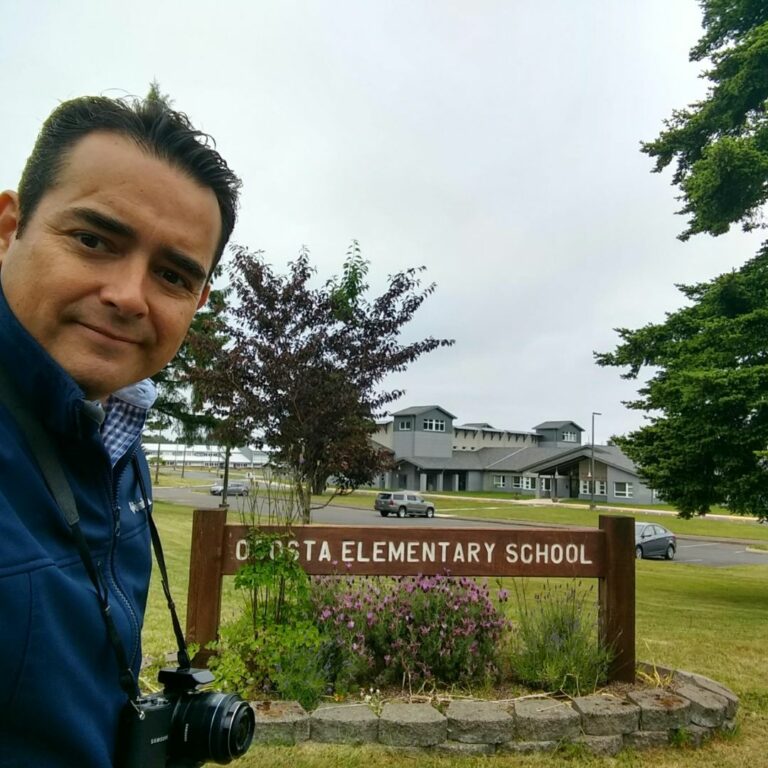
1. Ocosta Elementary School in Westport, Washington.
My visit to the Ocosta Elementary School in Westport, Washington (WA) in 2018, had a clear objective, to meet the first vertical Anti-Tsunami shelter United States of America (USA) and the only one of its kind in the entire continent, I managed to get an invitation given my interest in development of critical infrastructure for civil protection and civil defense and for my years as an engineer in port areas, I also attended a FEMA (Federal Emergency Management Agency) event in Seattle, WA.
I learned a couple of lessons that I want to share with you.

2. Location of Ocosta Elementary School in the USA (top left)
I. THE CONTEXT
Cinema has brought us thrilling movies about natural catastrophes with great special effects, where families as a focal point where take care of each other or rescue each other, or where one hero saves many, and the movie is a symbol of heroism and an opportunity to show love for others and fear for nature; the movies are commonly based on predictions of a great earthquake that will bring down bridges, collapse large buildings and as a main course will bring a powerful tsunami with a big wave that goes straight to a big city with millions of inhabitants in total vulnerability, fearful and helpless; For this, the famous and fearsome San Andreas fault has been frequently used, specifically off the coast of California (USA), however, little and almost never mentioned is the Cascadia fault (USA-Canada), which is as threatening as the San Andreas, had you heard of it?
The Cascadia is a fault of more than 1,100 km (684 mi) that spans from Vancouver, Canada, to Eureka, California, through the coastal edge of the states of Washington and Oregon in USA; prior to launch SBMX today SB Global in 2020 I did extensive research on Shelter Engineering since 2015, and came to know of this colossal Tsunami shelter, designed and built exprofeso in an elementary school in Westport, WA (Washington state), a fishing community that barely reaches 2,500 inhabitants, and that rose to fame for this shelter that its residents built by paying an extra tax for a certain period of time to have it in their community, so I took the task of knowing it and now I show you this interesting place.
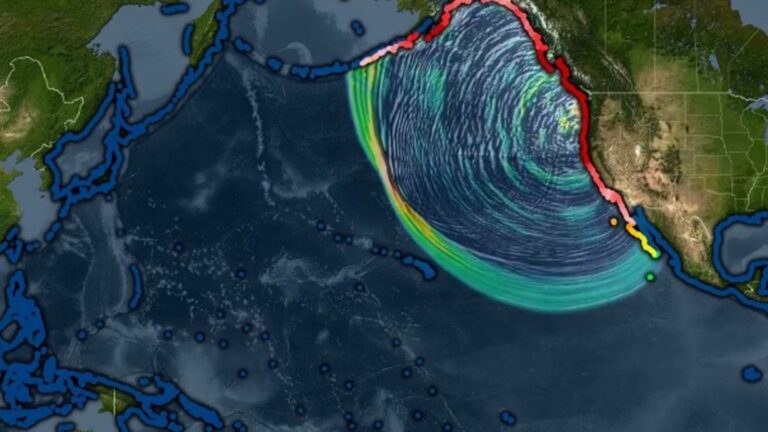
3. Simulated Cascadia subduction zone earthquake that sent tsunami waves. all the way across the Pacific Ocean to the coast of Japan. https://twitter.com/i/status/1354217604202696704
II. THE VISIT and KURT COBAIN
I arrived at the Seattle airport from Mexico City, I had booked a room in a hotel in front of the famous first Starbucks in the world, located in Pike Place Market, this mythical Starbucks was opened in 1971, and surprisingly it is not a modern or ostentatious Starbucks coffee, rather it is modest and its furniture had at least a dozen years, however, it is a wonder to have a coffee in iconic store.
My main destination was Westport, WA, a town of 2,250 inhabitants with an area of 15.38 km2 , which is just over 200 km (124 mi) from Seattle, it was essential to move around in a car, since, unlike Europe, in the USA the city-habitant design is very much associated with the use of private vehicles, so I rented a compact car at the Seattle airport.
Before heading to Westport I attended in Seattle (by invitation) an event of the FEMA (Federal Emergency Management Agency), the event called “Tsunami Maritime Guidance Workshop (20/06/2018)”, where I met two fellow engineers and researchers in coastal engineering phenomena that already live and work in the USA: Eduardo Sierra and Pablo Quiroga, my stay and the interesting event were connected to achieve a very complete trip related to Tsunamis.
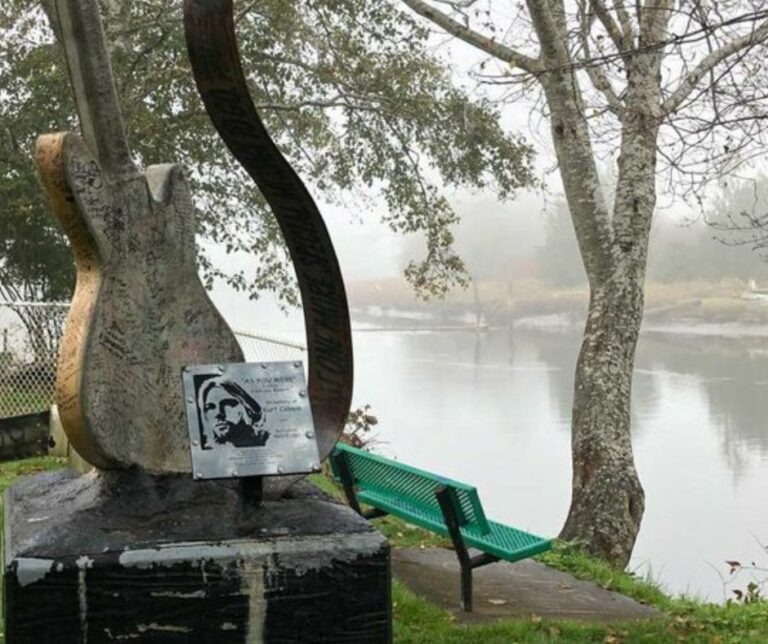
4. Monument in honor of Kurt Cobain (Nirvana)
I drove to Westport, where I would visit the Refuge, “curiously” the car had California plates, where is the other threatening fault, the San Andreas, I drove to Westport, it should be added that my adolescence and part of my youth belong to the 90’s, so after the interesting city of Tacoma, WA, I arrived to the now famous town of Aberdeen, WA., a must before arriving to Westport, there was born the famous grunge singer Kurt Cobain, I stopped for a coffee in a local store and visited a monument in his honor, I listened to “Come as you are” by Nirvana, I had on one side the Wishkah river, a beautiful place to honor a talented artist.
My visit in Westport had 2 phases, a private meeting with the District Superintendent Mr. Kurt Hilyard, and a visit to the shelter facilities, and I had only one condition, to avoid photographing the faces of the local children, since my visit was during business hours, and the shelter facilities are part of the school complex.

5. Meeting area before entering the refuge
2.1 PHASE 1 THE INTERVIEW
I was kindly received by David Dooley in the parking lot of Ocosta Elementary, and he took me to Mr. Kurt Hilyard Superintendent of Ocosta Elementary (2017-2019), already with him in his office I could perceive that he is a tremendously formal person, he showed great focus on what he was doing, he was slow in his movements and that denoted that he was looking to be efficient in his activities; I think that being a school principal entails that everyone looks at you, that you are an example, Mr. Hilyard was very kind to me, but he was very punctual, it was like a brief meeting, it was not a time to drink coffee, eat cookies and talk about topics such as how was your flight?, or why the Mariachis so cheerful? No, it was a moment of What can I do for you? there is lot of work to do?
For the meeting with Mr. Hilyard, I carried an agenda and mainly carried questions, non-technical, they were questions regarding the meaning of the shelter to him, the school, and the community.
I brought up to 5 questions for him, my goal was to explore his mindset and opinion about the shelter. Since English was not my mother tongue, I had to structure my meeting well at least in the topic to be discussed, and in order not to get lost, my questions were as direct as possible.
I expose only 2 (two) questions that their answers marked me and gave all the sense to my trip:
Question 1
What is more worrisome to you if an earthquake and resulting tsunami were to occur and school were in session?
With that question I was looking for an answer related to the rehearsals or drills of the children to go up to the refuge, I was looking to talk about the organization and control before a massive arrival of people to the refuge, however his answer was, “What worries more is how the vertical refuge will behave due to the impact of trees, cars and other objects on its structure”, while he said it his blue eyes like the ocean moved from left to right; I noticed that he was not worried about the organization or the terrible waves, but the impact elements dragged by the waves and the strong currents, these objects are called ‘Debris’ and are very destructive and even deadly, they are pieces that can weigh hundreds of kilograms or tons that float and move at more than 30 feet per second, there is no time to react; However, although the shelter was specially designed for that, I could infer that his concern was because he had the sequence of events in his mind and knows what such an event means. Mr. Hilyard was aware of how this phenomenon would occur and in his mind the event was unfolding, by not being mainly concerned about the organization, he showed me that he was prepared, and that they have several evacuation drills to the shelter every year, they are ready for an imminent threat of earthquake and tsunami.
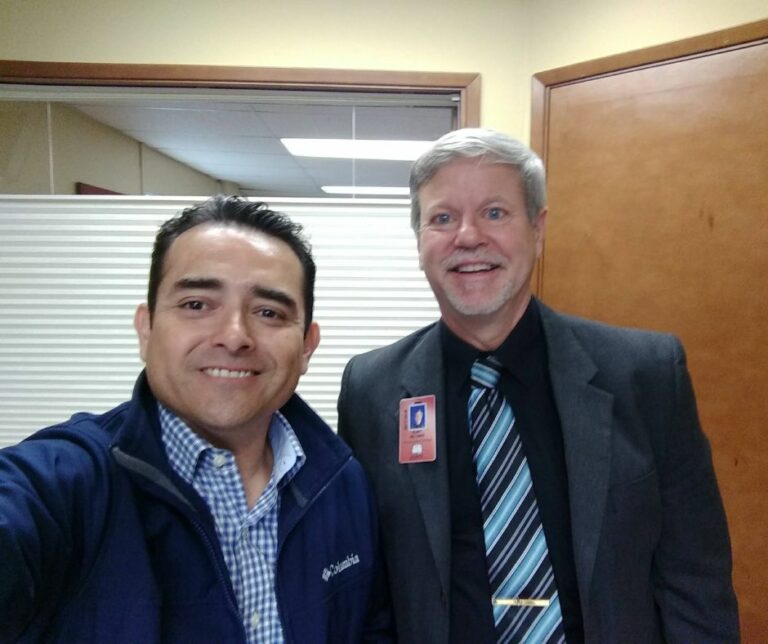
6. With Ocosta District Superintendent Mr. Kurt Hilyard, (in his office)
The above suggests to me that uncertainty is always present even in those who are prepared, since even with having a vertical anti-tsunami shelter there was in Mr. Hilyard a hint of uncertainty, if we extrapolate this, we can infer the following in terms of preparedness and civil protection:
Those who live in areas of risk and high vulnerability “and do nothing” is because human beings commonly do two things, 1) leave their future and destiny in a celestial entity or 2) anesthetize their mind to the threat, turning off the uncertainty or concern, they do nothing. And it is not for lack of uncertainty or fear, it is mainly because the mind has been trained to omit the threat to which it is exposed. Therefore, my research gave me a guideline:
I could not offer critical infrastructure solutions to disinterested or anesthetized people, only to who are aware of their environment, who know they have a direct or indirect threat looming and who want to do something to avoid vulnerable exposure and reduce its impact.
Question 2.
Have you noticed any change in the behavior of children who know that in the event of a disaster of such magnitude they will have a place to shelter with their family and friends?
He answered me emphatically yes, moving his eyebrows upwards and opening his eyes wider, he said, “They feel SAFE, they feel PROTECTED, they are very participative in the drills”. Also, within the question I asked another question, do you sense pride in the children? Yes, he answered, “they feel a huge pride”.
I inferred without hesitation that the pride was in belonging to their school and the achievement of their community, having a shelter of such magnitude, they feel safe and feel valued, this is an important factor for their (children) mindset and self-perception, it is a great gift for their future.
2.1.1 Family, security and pride
Family, security and pride is the triangle of focus of our offer. Hilyard’s answers touched my heart and my mind, as they gave me two (2) axes or guidelines to promote my product and help as many people as possible, and I had just found something intangible, perhaps more important than the fact of knowing the shelter and having traveled thousands of miles, it was a matter of essence, neither physical, nor corporeal.
First one: Attract or find the right people who seek a higher level of security than average, families seeking safety as a precaution rather than fear something or someone specific, and
The second: To provide the new generations with greater security and pride in having an advantage over others and their environment.
A child who experiences security and pride grows differently and reaches adulthood with abysmal emotional advantages. A father or mother, or both parents in tune with each other, who provide their children with these factors, whether tangible or intangible, whether specific goals or objectives, will give a great gift to their sons and daughters, who in their adult life will also give them, and to a greater extent.
My purpose of developing shelters for families, for parents and children, for grandchildren and grandparents is simply to bring solutions that provide them with Security and also Pride or Valuation; and within the purpose it will be a great challenge to make these infrastructures accessible at all levels, and for different catastrophes.
2.2 PHASE 2 THE SHELTER
2.2.1 Ocosta Elementary School’s Triple Preparedness: Earthquakes, Tsunamis and Unconventional Events
Since my arrival I was kindly received by David Dooley (Principal Ocosta Jul 2016 to Jul 2018), and he was in charge of the tour accompanied by Steve Shcmeling, and it really was great tour, I consider that within minutes of meeting David I made a friend, too bad I had no contact with him for a long time because of his move to Hawaii and because I wrote down his data wrong, but now I managed to find him through LinkedIn, thanks to UN videos about the Ocosta refuge, I leave those videos at the end of the text.
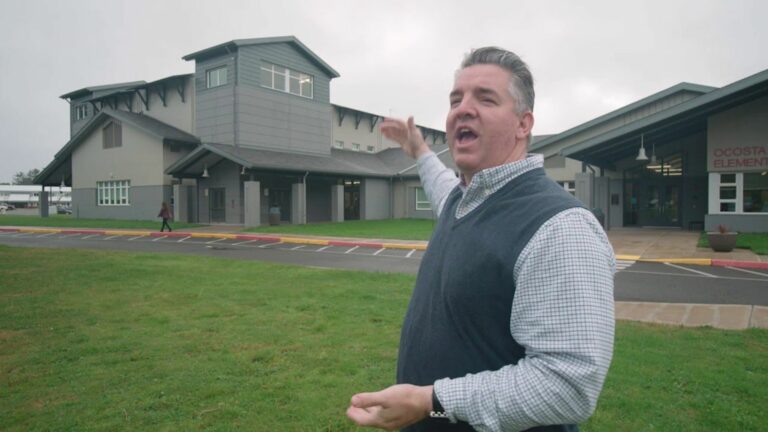
7. David Dooley showing the location of the Tsunami Shelter
After the meeting with Mr. Hilyard, we left the main building, I was taken to another building, we entered and passed by a cafeteria and a gym and then what we did was to go upstairs, quite wide (8 feet wide), when I finished climbing the stairs I came to a warehouse with wide shelves, it was a storage room, and then I went out to a large esplanade, it was a rooftop, literally I was on the roof of the cafeteria and the gym, we were in the open sky, and oh surprise, it was already the shelter, It was the opposite of an underground shelter, which is full of pipes, ventilation systems, artificial lighting and blast doors, there at that moment we were surrounded by a cloudy sky, were dense white clouds, but there were spaces of blue sky, the weather was chilly and you could smell of forest, I had arrived, period! I had crossed half of Mexico and all of the USA to see it and be there, I was in an “open air bunker” that was anti-wave, anti-flood, that did not look like one, but it was, robustly it was.
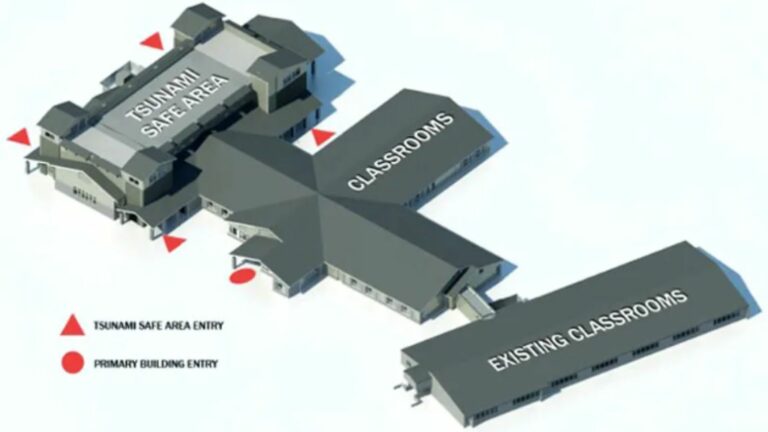
8. Layout of the facilities, (source: TCF Architecture)
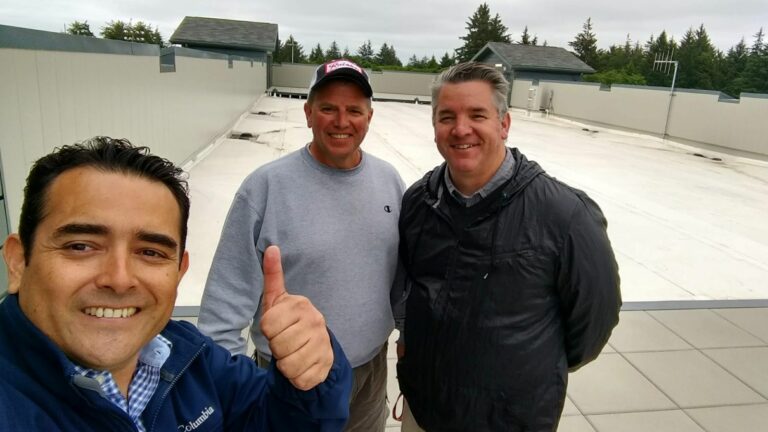
9. Steve Schmeling (left) and David Dooley (right), the three of them in the anti-tsunami safe zone (rooftop level).
The “Anti-Tsunami safe area” has 4 entrances or 4 stairways, there were 4 large towers, one in each corner of the safe area, described as the 4 large legs of a huge and high table, it was like accessing a stadium, the esplanade of about 50 feet wide and 165 feet long, was framed by stair towers built with 14 inches (35 cm) thick walls, with dozens of tons of steel reinforcement, and each stair tower ended in its own warehouse to store food, ponchos, water, etc., for staying of 1 to 4 days for more than 1,000 people, and to sustain them until rescue arrived.
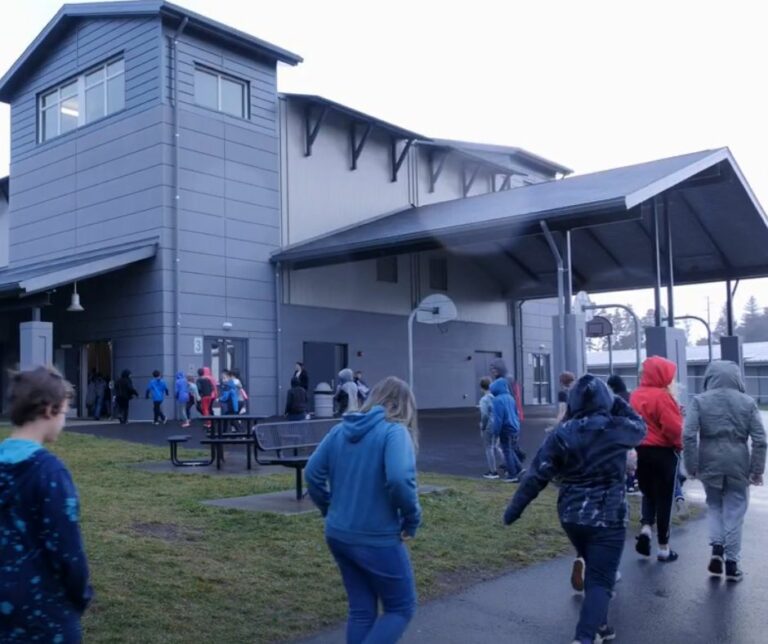
10. Simulation in progress
The Anti-Tsunami safe area had in its perimeter high concrete walls with a thickness of up to 10 inches (25 cm), with equidistant interspaces that were like lookouts or observation points, the walls reached 7 feet high (2.1 m), they were not railings, it was not a place for contemplation, it was for observation, precisely we were not in a place to contemplate the sea but to protect us from it; it was a civilian shelter on top, to withstand a Tsunami produced by a tsunami-genic earthquake of magnitude 9.1 and waves more than 22 feet high (6.7 m), which would produce fast currents greater than 20 knots, more than 10 m/s (30 ft/sec) or more than 36 km/hr, a very high speed if you imagine a car floating in the water moving towards you at that speed and you trying to swim through branches, pieces of wood and electrical wires to get out of its path, and it would not be a single object coming towards you, it would be several. An event of this magnitude has a duration of 12 to 24 hours, it is not a matter of a few minutes.
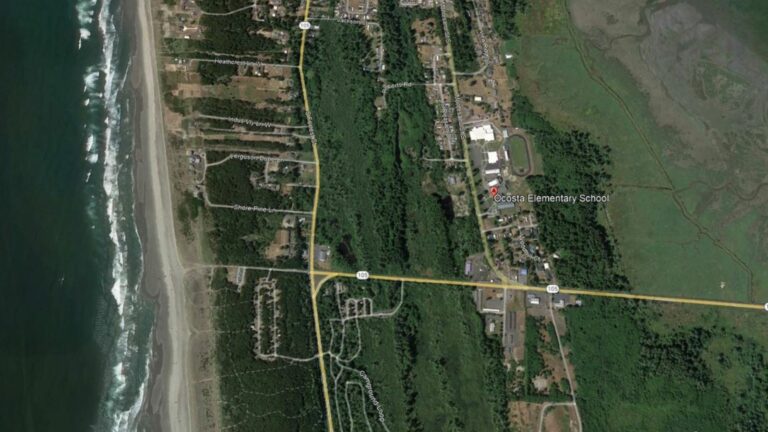
11. Location of the OCOSTA school and its proximity to the coastline

12. OCOSTA Elementary School Complex

13. Mock ascent to the Tsunami Shelter (source: Degenkolb Engineers)
The school has institutionalized evacuation drills and ascent to the shelter, has a public address system, sound alarms, and two panic buttons in the main building, at that time in charge of David Dooley, one of them activates the system in case of tsunamis and earthquakes unlocking the doors of the shelter, even if the school is without staff; but yes, if you press the Lockdown button, it is because the threat is “unconventional” perhaps an active shooter and everything is closed, and why? Between 2012 and 2022 there have been 189 school shootings in the USA, the first at Sandy Hook Elementary in Connecticut.
It is important to note that shelters by design must be redundant, their safety is multifactorial events, and it is something that can make projects more expensive, but that additional investment and institutional type user training can save many lives.
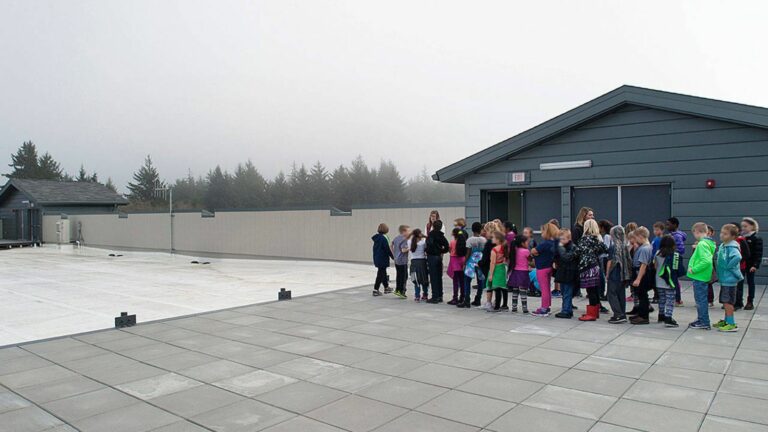
14. Tsunami Drill (source: Degenkolb Engineers)
The project and its assumptions

15. Layout of the structure (source: Degenkolb Engineers)
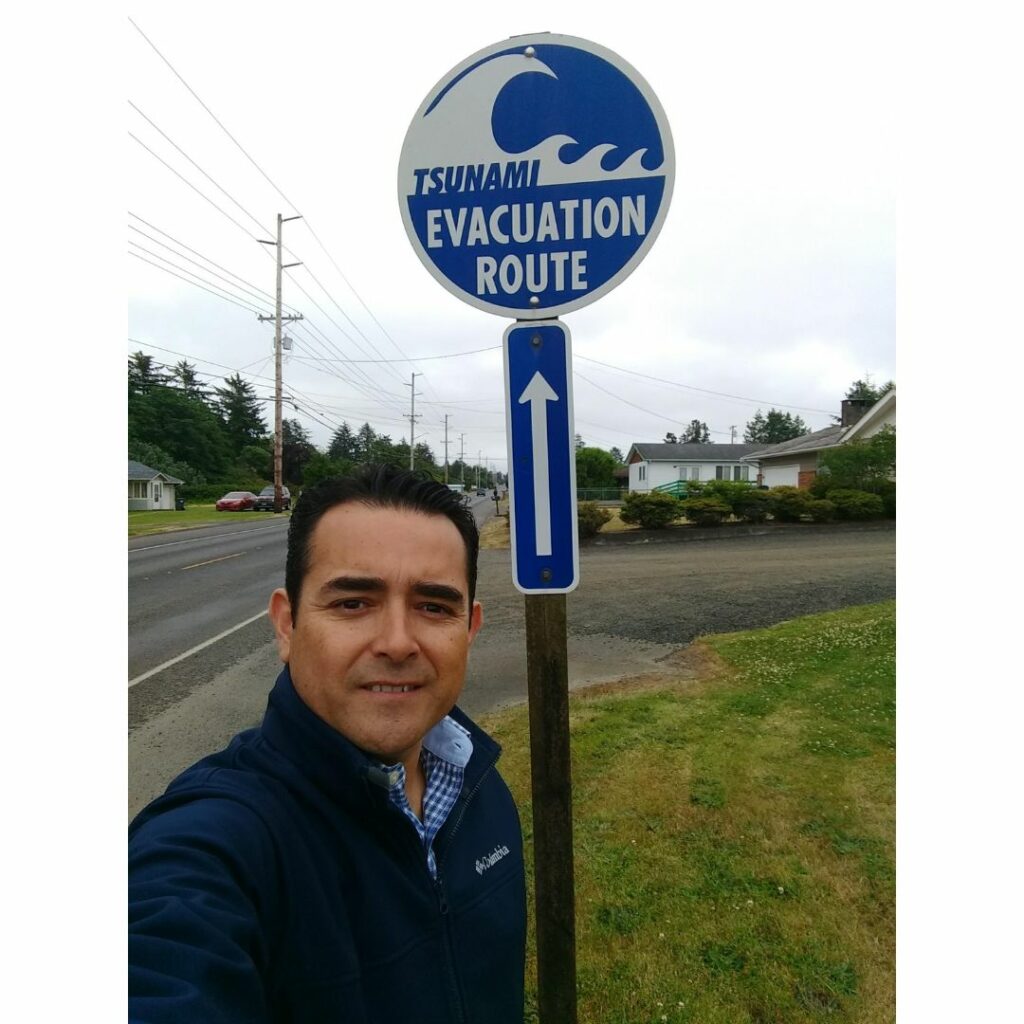
16. Evacuation route signage (Westport, WA. streets).
Unlike Japanese standards for tsunami shelters, which are generally steel structures, the Ocosta Primary shelter is made of reinforced concrete, and its foundation is of the deep to deep type, base of piles constructed on site by rotary drilling to the depth of the resistant stratum.
Designing this type of infrastructure both in Architecture and Engineering requires assuming certain assumptions, modeled assumptions that come from research and reflection, and that in theory would be realities that must be faced, I call them the “driving agents or drivers” which we must repel, control and take advantage of, I mention 10 assumptions of which I had knowledge:
- Earthquake scenario: magnitude 9.1 in the Cascadia subduction zone.
- Design wave height, produced by the earthquake up to 22 ft (6.7 m), minimum 6 ft (1.8 m) over the wave crest and flooding height.
- Organization time (Ocosta Elementary) after the earthquake 10 minutes plus evacuation time (ascent) to the shelter 15 minutes (students and teachers), so 25 minutes.
- Arrival time of the first Tsunami wave 40 minutes
- Travel time of inhabitants from the outside to the refuge on foot 25 to 38 minutes
- Distance traveled in 15 minutes by a healthy person 3,600 ft (1,097 m) and a moderately healthy person 2,700 ft (823 m) in the same time.
- Distance from the center of the Westport community to the refuge 8,860 feet (2,700 m) equals 36 minutes walking time.
- Signposted evacuation route, with assembly points for group leadership.
- Communication will be by voice and via walkie-talkie radios (cellular antennas are expected to be collapsed).
- Vehicles will not be allowed to go to the Ocosta refuge.
III. REFLECTIONS
- Risk is the same for everyone, vulnerability is different for everyone and depends largely on personal and family actions.
- Engineering and technology exists, it just needs to be brought closer to the civilian population, and someone has to do it, and the faster the better.
- Children, and teenagers, these the new generations need to have confidence in the future, to allow themselves to be creative and have the decision to pay the price of the effort, the sacrifice involved in creating a productive, cultured and healthy life; we have gone from a utopian future to a dystopian future, viral press, social networks, labor instability, geopolitics and also the visible changes in the climate cloud the future, it is up to us to open a better panorama.
IV. WHO DESIGNED IT?
The waterfront community of Westport, WA, was designed by TCF Architecture and Degenkolb Engineers. Learn about the designers’ portfolios and experience at:
V. THANK YOU FOR YOUR HOSPITALITY IN WESTPORT AND SEATTLE, WA.
To Mr. Kurt Hilyard, for giving me authorization and all the facilities to visit the Refuge.
To David Dooley and Steve Schmeling, for their attentions and terrific tour.
OCOSTA ELEMENTARY SCHOOL (Westport, WA)
To Maximilian Dixon, and Keily Yemm
WASHINGTON STATE EMERGENCY MANAGEMENT DIVISION (Seattle, WA)
To Eduardo Sierra and Pablo Quiroga;
FRIENDS AND COASTAL ENGINEERS & OCEANOGRAPHERS (Seattle, WA)
VI. VIDEOS OF THE TSUNAMI SHELTER ON THE WEB (YOUTUBE)
UN shelter at Ocosta Elementary School
KING 5 SEATTLE
Build to last: Tsunami and earthquake drills in Westport (USA)
Learn more about the Cascadia fault in this link: https://www.bbc.com/mundo/noticias/2015/07/150721_eeuu_falla_cascadia_terremoto_tsunami_jg
VII. A NEW GOAL IN PROCESS
SB Global® is working on the VERT® project (design and construction) of a vertical anti-tsunami shelter for the Pacific coasts of Mexico and LATAM, which could be acquired by local governments and private companies.
SB Global HQ Mexico already in operation and with projects under construction in different parts of the country (private projects) is just the beginning, the effort for VERT is broad and ambitious, in terms of determining wave heights in different points of interest in the Pacific coasts of the American continent; however, there is engineering and there are engineers, and we work on that. Without Vision there is no Action.
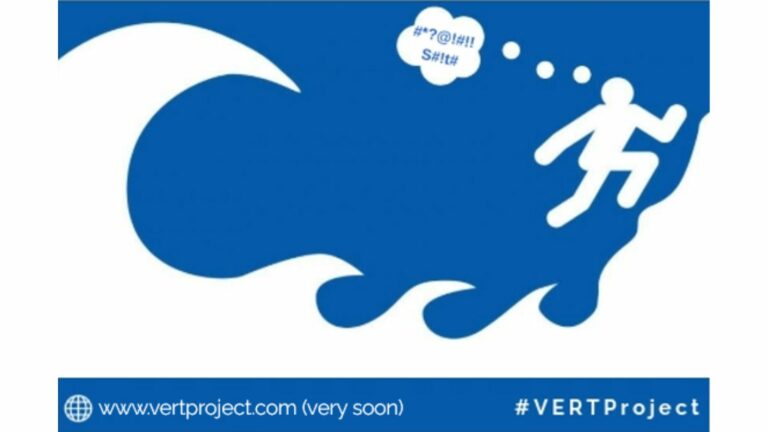
17. VERT PROJECT

